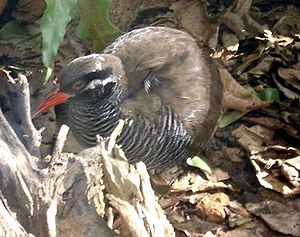Okinawaralle
| Okinawaralle | ||||||||||
|---|---|---|---|---|---|---|---|---|---|---|

Okinawaralle ( Gallirallus okinawae ) |
||||||||||
| Systematics | ||||||||||
|
||||||||||
| Scientific name | ||||||||||
| Gallirallus okinawae | ||||||||||
| ( Yamashina & T. Mano , 1981) |
The Okinawaralle ( Gallirallus okinawae ) is a species of rail that is endemic to the Japanese island of Okinawa Hontō . It was only discovered in 1978 and described in 1981.
features
The Okinawaralle reaches a length of 30 cm and a wingspan of 50 cm. She is almost unable to fly. The tail is very short and tattered. The legs are long and strong. The entire top and upper wings are dark olive brown. The chin, throat, sides of the face and neck are black. A whitish cheek spot and a white line run from the base of the eyes over the ear covers down to the neck. Some outer hand wings have narrow white bands on the outer flags. The inner wings of the hand have broad, brownish-yellow bands. The underside is black with narrow white wavy lines. The under tail-coverts are black-brown with a buff-white banding. The beak is scarlet. The tip of the beak is ivory in color. The eye ring, iris, legs and feet are red. The sexes look the same. Apart from the darker ridges and tips of the beak, the immature birds look similar to the adult birds. The top and head of juvenile birds are tinted light olive. The underside is marbled. The bill and iris are brown. Feet and legs are flesh-colored yellowish ocher.
Vocalizations
The Okinawaralle's voice is loud. The call includes tones that sound like "kwi kwi kwi ki-kwee k-kwee", "ki-ki-ki" and "kyip kyip kyip kyip". A rolling "kikirr kikirr" is followed by an ascending series of "kwee" tones, which at the end have similarities with the squeak of pigs. Another call is reminiscent of horse lulling. The calls can usually be heard in the early morning, late afternoon and evening.
Occurrence and habitat
The Okinawaralle inhabits subtropical, evergreen deciduous forests with dense undergrowth and some bodies of water. It occurs mainly in primary and secondary forests, along forest edges and in small forest parcels. It can also be found in bushland or in cultivated areas near forests, where the soil is moist and there are streams, ponds or water reservoirs. The distribution area extends to the northern quarter of Okinawa Hontō in the region of Yambaru north of the line Shioya (district of Ōgimi ) and Higashi .
Way of life
The Okinawaralle mainly lives on the ground, where it preyes on insects, snails and amphibians. She finds more food in shallow water when she goes to the ponds to swim and drink. She is a monogamous bird . The breeding season is from May to July. The nest is built on the ground or in a hollowed-out tree stump and padded with leaves, grass and fronds of ferns. The clutch consists of two to three eggs.
Existence and endangerment
BirdLife International classifies the Okinawaralle in the “endangered” category . Expeditions between 1996 and 2004 showed that the stock had dropped from around 1,800 to just 717. The main threat is the stalking by the little mongoose introduced to Okinawa . In addition, there is clearing, dam construction, road construction, arable farming and the construction of golf courses. Feral dogs, cats and thick-billed crows also hunt the Okinawaralle. Many adult birds are run over during the breeding season.
Systematics
This species was first described in 1981 by Yoshimaro Yamashina and T. Mano on the basis of a dead specimen that was discovered on June 2, 1981 at Mount Fuenchiji in the Kunigami district on Okinawa Hontō. The Okinawaralle was originally classified as belonging to the genus Rallus , but then placed in the genus Gallirallus . It is closely related to the Calayan's rail ( Gallirallus calayanensis ), a species that was only discovered in 2004.
literature
- Josep del Hoyo , Andrew Elliot, Jordi Sargatal : Handbook of the birds of the world. Volume 3: Hoatzin to Auks. Lynx Edicions, Barcelona 1996, ISBN 84-87334-20-2 .
- P. Barry Taylor & Ber van Perlo: Rails: A Guide to the Rails, Crakes, Gallinules, and Coots of the World. Yale University Press, New Haven 1998, ISBN 0-300-07758-0 .
Web links
- BirdLife Species Factsheet.
- Oriental Bird Images: Photos from Okinawaralle
- ARKive - Pictures and information about the Okinawaralle
- Photos and information about the Okinawaralle (Japanese)
- Hypotaenidia okinawae inthe IUCN Red List of Threatened Species 2013.2. Listed by: BirdLife International, 2013. Retrieved February 6, 2014.